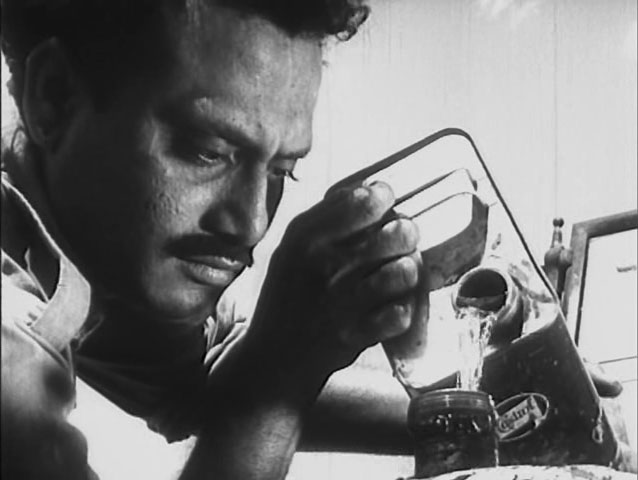At a crucial moment in Ritwik Ghatak’s Ajantrik (frequently translated as The Pathetic Fallacy), our hero Bimal strokes the most important person in his life and says, “Never mind, Jaggadal. You and I … we’re together.”
It’s a poignant moment, this Bengali portrait of devotion and erotic desire in the face of widespread mockery and community derision.
Also, Jaggadal is his car.
 Ajantrik channels many modes simultaneously: manic slapstick, Brechtian absurdity, deeply felt commentary on social conditions. Satyajit Ray is commonly credited with founding Indian parallel cinema, mixing social realist tropes with local concerns as a quiet rebuttal to mainstream movies, but there’s a good argument that Ghatak — with his first, pre-Pather Panchali film The Citizen — got there first. Ajantrik was his second. Its influences can be felt in Ray’s Abhijan four years later, and in the general outline of Ray-devotee Martin Scorsese’s Taxi Driver quite a bit later then that.
Ajantrik channels many modes simultaneously: manic slapstick, Brechtian absurdity, deeply felt commentary on social conditions. Satyajit Ray is commonly credited with founding Indian parallel cinema, mixing social realist tropes with local concerns as a quiet rebuttal to mainstream movies, but there’s a good argument that Ghatak — with his first, pre-Pather Panchali film The Citizen — got there first. Ajantrik was his second. Its influences can be felt in Ray’s Abhijan four years later, and in the general outline of Ray-devotee Martin Scorsese’s Taxi Driver quite a bit later then that.
Regardless of lineage, Ghatak seemed to be up to something different in Ajantrik. The film tells the story of Bimal, a man out of place and not in sync with his time. He too is a taxi driver, but refuses to give up his beloved Jaggadal, an aging, creaking, huffing and puffing car he’s had for over a decade. In his insistence that it’s never broken down, so why should he get a new one, you can hear every stubborn man refusing the latest invention.
But Ghatak mines deeper: even though his beloved is, as he’s constantly reminded by his incredulous boss and mocking neighbors, “a hunk of iron and steel,” Jaggadal is also a symbol that goes way beyond its physical manifestation. It’s a bit of pre-Partition nostalgia, and his clinging to seems to represent a rejection not just of newfangled imports but modernity itself.
 No one else’s car has a name. And certainly no one would lavish upon their car the care he reserves for Jaggadal. His self-identity is bound up with this thing, which, in Ghatak’s hands, takes on a life of its own. Long before the Disney-helmed Bernie series, post-production sound design give Jaggadal an almost corporeal personality: the car is essentially the main character of the film with Bimal in the supporting role. As Stephen Holden notes, the car constantly produces “a comic symphony of wheezes, honks and rattles.”
No one else’s car has a name. And certainly no one would lavish upon their car the care he reserves for Jaggadal. His self-identity is bound up with this thing, which, in Ghatak’s hands, takes on a life of its own. Long before the Disney-helmed Bernie series, post-production sound design give Jaggadal an almost corporeal personality: the car is essentially the main character of the film with Bimal in the supporting role. As Stephen Holden notes, the car constantly produces “a comic symphony of wheezes, honks and rattles.”
All of this is very funny and very ridiculous, but Ghatak isn’t just out for Hulot-like laughs. Another crucial scene features Bimal coming across a ceremony as he struggles to get Jaggadal moving again. Omar Ahmed writes:
One could definitely label this as a road movie, with Bimal’s episodic journey across the plains of the Ganges delta providing some illuminating compositions of rural landscapes. However, it is the observation of the Oraons tribe through the elaborate dance rituals that offers a glimpse of Ghatak’s personal ethnographic fascination with marginalised cultures and people…
In the scene, though, you get the sense that Bimal isn’t comfortable here, either. The observed ritual seems to evoke an even more distant past, one further remote from his struggles than his uncomfortable segue into an unsure modern age. He simply has his car, and he wants to keep it.
It’s not to be. When Jaggadal finally gives up the ghost and is sold for scrap, Bimal treats it as a funeral, perhaps his own. (Ghatak underlines this: Bilal apparently lives right next to a graveyard.)
The eroticism of the earlier scenes isn’t exactly David Cronenberg’s Crash, but the fierce merging of man and machine is evident. We close on a child playing with the car horn, the only piece that survived — appropriately enough, for a film obsessed with noises, the sound-making one. His delight brings a smile to Bimal’s face. Perhaps Jaggadal lives on.
It could be a nostalgic vision only, except that the goofball laughs end up being played straight. There’s certainly something silly about a man whispering to his car, but Ghatak infuses the film with so much historically specific pathos that it feels more like a eulogy.
A eulogy for an inanimate fetish object, sure, but a eulogy all the same.

